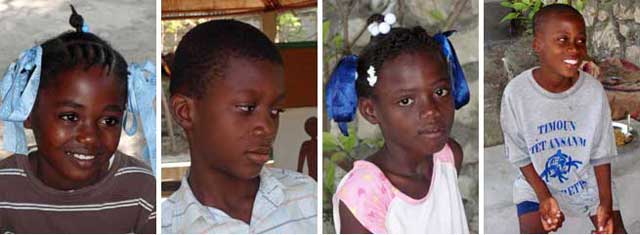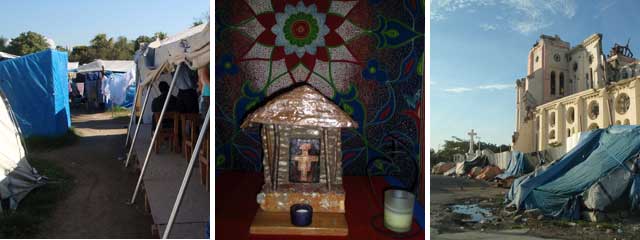



Photos by Lolin Menendez, rscj
“Brushstrokes”, because the days were not enough to deepen what I saw, what I felt, what I received.
Flying over the capital and seeing it dotted by thousands of tents moves the heart. Most green spaces are transformed into a mass of blue and white… As soon as one leaves the airport grounds, the powerful impact of tents lining the road, occupying every available space… Tents that “bother” –old, dirty, torn. They do not belong in the urban landscape.
Piles of rubble, dozens collapsed houses, many of them still containing the remains of their occupants. Yes, there is some work of rebuilding being done, but it is so small in proportion to the task that awaits the country. Garbage-choked canals, breeding grounds for cholera, offer perhaps the only alternative to get some water.
But life teems in the streets, and is stronger. Every sidewalk is dotted with small stalls selling everything from bananas to engine oil.. Multicolored traffic of taptaps (buses painted with bright pictures) which, in addition to providing transportation also raise a prayer: "Tell it all to Jesus." "Are you sad? Jesus is your hope." Young people go from village to village to spread information about cholera. Children walk to school in spotless uniforms, hair braided with matching ribbons. Seeds of a future.
There are only four of RSCJ in Haiti, grains of hope amid so many needs. They make a contribution to the rebuilding of Haiti through their relationships with people, be they university students, children, religious or neighbors. The hidden work of "building" people, offering tools, values, treating them with dignity. This is palpable in conversations with the sisters, far beyond what one can see.

In Verrettes, the RSCJ have been involved for many years in "Timoun Tet Ansam” (Children Together), a program where wide-eyed children learn and play with a discipline that comes from within. The dignity of these small ones who carefully carry a plate of food to the place where the "family" (a small learning group) meets. Activities that learn more than words and ideas. Monitors who smile as they inculcate values of peace, cooperation and self-esteem. Young people who pass on what they have received. Promise for the future.
Three images suggest what I lived those days.

Sunday, praying with residents of a camp for the displaced. The "church", a large tent, headquarters for the “Faith and Joy” program and the Jesuit Refugee Service. The tent of Emmanuel, God-with-us in the midst of so much suffering. For me, a tent of meeting, a joyous and fortuitous reunion with a Spanish Jesuit with whom I had worked in the Great Lakes region of Africa for many years.
The tabernacle of the house of the community of Port-au-Prince, shaped like a small Haitian house. Jesus, present in each house of the country.
The ruins of the cathedral in Port-au-Prince provide shade for dilapidated tents.
The Word pitched his tent among us,
This time in Haiti.
And we allow him to continue living
Without a roof, frail, helpless,
In precarious shacks.
Canvas tents shelter the Word
Much better than a palace of cement.
Lolín Menéndez, rscj
Province of Puerto Rico–Haiti
February 2011

